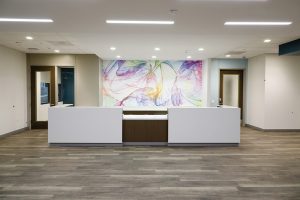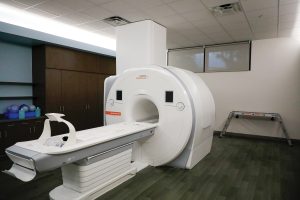Pushing Boundaries with UNT Health Science Center
The University of North Texas (UNT) Health Science Center is about to launch a research study that could transform the way Alzheimer’s disease is diagnosed—but before the research team could change the face of medicine, the school had to make a few changes of their own.
Currently, Alzheimer’s disease plagues more than five million Americans and can only be detected through a series of expensive tests, including MRIs, PET scans, and sometimes even a lumbar puncture. Dr. Sid O’Bryant, PhD, Professor of Pharmacology and Neuroscience, and the lead researcher on the study believes a biomarker protein in the blood might be the key to diagnosing patients earlier and at a much lower cost. This three-year study is the first of its kind and, if successful, will allow medical professionals to detect Alzheimer’s with a simple blood test in a primary care setting. UNT partnered with Structure Tone Southwest and Boulder Associates, Inc. to turn 12,580sf of their campus into a state-of-the-art research space designed to suit the specific needs of the study.

ON A MISSION
In order to confirm the effectiveness and accuracy of the blood test in detecting Alzheimer’s disease, the study requires two separate areas—a space where the research team will draw blood from participants and process those samples, and a diagnostic imaging area where the team will compare the blood test results with each patient’s brain scans. To satisfy grant requirements, the research space needed to be complete in just six months, so Structure Tone Southwest developed a unique approach to meet UNT’s tight timeline.
Rather than building the entire space from a construction perspective and moving the four massive pieces of imaging equipment—two 3T MRI machines and two PET/CT machines—into the space. Afterward, the project team decided to move the huge MRI magnets into the rooms while the facility was still under construction. This meant they wouldn’t have to remove completed work when it was finally time to install the machines, but it also led to a few challenges:
1. Gaining buy-in. Siemens Healthineers, UNT’s imaging equipment supplier, has a standard process for installing any of their machines to ensure the equipment isn’t damaged in the process, and they almost never allow their products to be brought in while construction is still in progress. “On 99% of jobs, Siemens will not bring a piece of equipment in until they have a completely built room,” says Rylan Yackey, Structure Tone Southwest project manager. “We brought the Siemens team on within the first two weeks of construction to start that conversation early on.” Siemens was included in page-turn meetings with subcontractors from the get-go, and having worked with Yackey before, agreed to allow the magnets to be brought in earlier than usual.
2. Managing the risk. Once Siemens was on board, the team needed to ensure the magnets were protected. Typically, they would build a box around the magnet to minimize the risk of damage while the trades continued working around them. In this case, the project team waited until the walls and ceilings were built. Then, all the team needed to do was patch the walls where the equipment had been brought in so the trades could continue installing the ceiling grid, millwork, and painting the final space.

LEANING ON TECH
Working on this fast-paced schedule, the project team used STSW’s BIM experts to coordinate the building’s mechanical systems. They used BIM visualization to find an entry point and travel path before moving the heavy machinery through the building so the structure wouldn’t be compromised. The team also used the Matterport 3D camera to capture the post-demo ceilings and later, used the tool again to conduct the above-ceiling inspection. “The project was based on a six-month schedule and that is extremely accelerated to build out four rooms like this,” Yackey says. “We used all the tools we had to our advantage in order to meet UNT’s timeline goals.”
CAMPUS CONSTRUCTION
Work on the university’s new research facilities was supposed to occur while school was still in session—meaning the team was prepared for all the complexities of working on an occupied college campus. However, construction kicked off right as COVID-19 reached the United States. Once the school switched to virtual learning, the project team was able to build throughout the day, regardless of the nature—and noise level—of the work. Despite the project’s intense timeline, construction wrapped up in mid-September and Siemens has begun installing and calibrating the medical equipment. This November, UNT’s research staff will have two weeks of user training. The space and staff will be ready to begin their research by the end of the year.
